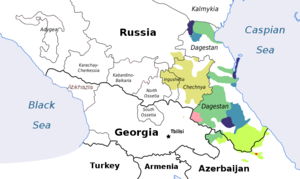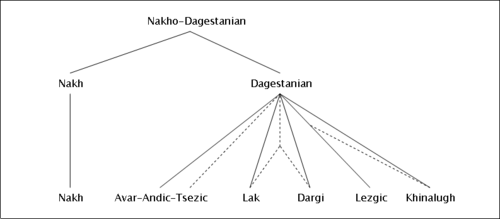لغات شمال شرق القوقاز
| شمال شرق القوقاز | |
|---|---|
| ناخ(و)-داغستانية، قزوينية | |
| Geographic distribution | — |
| Linguistic classification | شمال القوقاز ?
|
| Subdivisions | |
 | |
لغات شمال شرق القوقاز Northeast Caucasian languages تشكل عائلة لغات تُستخدم في الجمهوريات الروسية داغستان، چچنيا، إنگوشتيا، شمال أذربيجان، وفي شمال شرق جورجيا، وكذلك في تجمعات الشتات في روسيا، تركيا والشرق الأوسط. كما يُسمـَّوا الناخو-داغستانية / الناخ-داغستانية أو مجرد الداغستانية، أو أحياناً القزوينية، على النقيض من الپونطية التي تصف لغات شمال غرب القوقاز.
اسم العائلة
Several names have been in use for this family. The most common term, Northeast Caucasian, contrasts the three established families of the Caucasus language area: Northeast Caucasian, Northwest Caucasian, and South Caucasian (Kartvelian). This may be shortened to East Caucasian, especially by those linguists who accept the North Caucasian languages as a language family. The older term Nakho-Dagestanian reflected an erstwhile primary division of the family into Nakh and Dagestanian branches, a view which is no longer widely accepted. The rare term Caspian (that is, bordering the بحر قزوين) is only used in opposition to Pontic (that is, bordering the البحر الأسود) for the Northwest Caucasian languages.
تصنيف اللغات
 Traditional classification (Nichols (2003)) |
 Latest attempt at internal classification (Schulze (2009)) |
 Branching without relative chronology (Schulze (2009)) |
عائلة ناخ
مستخدمة في چچنيا وإنگوشتيا وجورجيا. الشيشانية والإنگوشية هما اللغتان الرسميتان لجمهوريتيهما.
- Batsbi (Bats) (3,420 speakers in Georgia in 2000)[1]
- Vainakh languages
عائلة أڤار-أندية
Spoken in the Northwest Dagestan highlands and western Dagestan. Avar is the lingua franca for these and the Tsezic languages and is the only literary language. Schulze (2009) gives the following family tree for the Avar–Andic languages:
- Avar (788,960)
- Andic languages
- Andi (Qwannab) (21,800)
- Akhvakh–Tindi
Figures retrieved from Ethnologue.[4]
Tsezic (Didoic) family
Spoken mostly in Southwest Dagestan. None are literary languages. Formerly classified geographically as East Tsezic (Hinukh, Bezta) and West Tsezic (Tsez, Khwarshi, Hunzib), these languages may actually form different subgroupings according to the latest research by Schulze (2009):
- Tsez–Hinukh
- Tsez (Dido) (15,000)
- Hinukh (Hinux, Ginukh) (200 speakers)
- Bezhta–Hunzib–Khwarshi
- Bezhta (Kapucha) (5,000)
- Hunzib (Gunzib) (2,000)
- Khwarshi (Khvarshi) (8,500)[5]
لك منعزلة
Spoken in the Central Dagestan highlands. Lak is a literary language.
- Lak (120,000 speakers)
درگي (درگين) - امتداد لهجات
Spoken by 370,000 in the Central Dagestan highlands. Dargwa proper is a literary language.
خينالوگ منعزلة
مستخدمة في شمال أذربيجان.
- خينالوگ (لغة) (3,125 متكلم)
العائلة اللزگية
مستخدمة في مرتفعات جنوب شرق داغستان وفي شمال أذربيجان. The Lezgian language or, as the Lezgian people themselves call it, Лезги чlал (lezgi ch'al), is the biggest in terms of the number of native speakers of all the languages of the Lezgic group (other languages from this group include Tabasaran, Udi, Tsakhur, and Rutul). Tabasaran was once thought to be the language with the largest number of grammatical cases at 54, which could, depending on the analysis, instead be the Tsez language with 64. The Lezgic family, along with a couple of other families (Avar–Andic, Tsezic, Lak, Dargin, and Khinalug), forms the Daghestanian part of the Nakh–Daghestanian language family (the Nakh part is constituted by Chechen, Ingush and related small languages).
Lezgian and Tabasaran are literary languages.
Lezgic family tree
الصلات بالعائلات الأخرى
عائلة شمال القوقاز
الهامش
طالع أيضاً
المراجع
- Khalilova, Zaira (2009). A Grammar of Khwarshi (PDF). University of Leiden: LOT, Netherlands. ISBN 978-90-78328-93-3.
- NICHOLS, Johanna (2003), "The Nakh-Daghestanian Consonant Correspondences", in TUITE, Kevin; HOLISKY, Dee Ann, Current Trends in Caucasian, East European, and Inner Asian Linguistics: Papers in Honor of Howard I. Aronson, Amsterdam: Benjamins, pp. 207–251, ISBN 978-1-58811-461-7, http://books.google.cz/books?id=REPC96ddSc0C&pg=PA207&dq=Current+Trends+in+Caucasian,+Inner+Asian+Nakh-Daghestanian
- SCHULZE, Wolfgang (January 31, 2009), "The Languages of the Caucasus" (PDF), http://wolfgangschulze.in-devir.com/index.php?option=com_docman&task=doc_download&gid=63
- SCHULZE, Wolfgang (2007), "Personalität in den ostkaukasischen Sprachen" (PDF), Munich Working Papers in Cognitive Typology, IATS University of Munich
- SCHULZE, Wolfgang (2001), "Die kaukasischen Sprachen", in M. Haspelmath et al., La typologie des langues et les universaux linguistiques, 2, Berlin/نيويورك: Mouton de Gruyter, pp. 1774–1796
- WUETHRICH, Bernice (19 May 2000), "Peering Into the Past, With Words", Science 288 (5469): 1158, doi:, http://www.sciencemag.org/cgi/content/full/288/5469/1158.
وصلات خارجية
- Various Northeast Caucasian language dictionaries online from IDS (select simple or advanced browsing)
- A nice map depicting all the languages in the Caucasus: http://www.hunmagyar.org/turan/caucasus/index.html
- CIA linguistic map of the Caucasus
- MultiTree Page for Northeast Caucasian languages
- Ethnologue: North Caucasian, Northeast